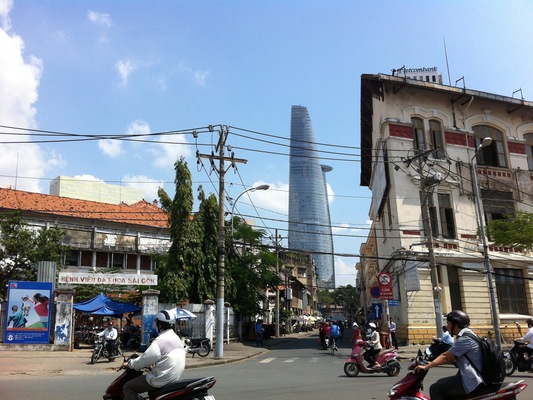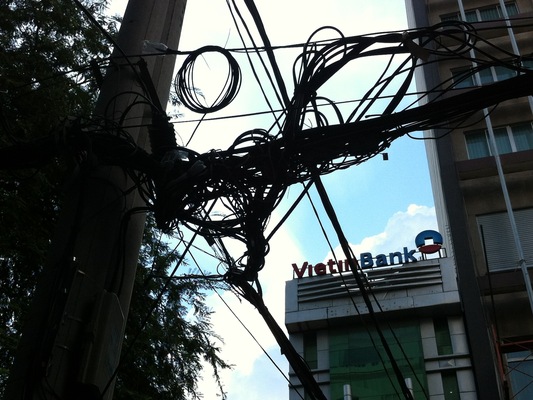- Upon returning to Ho Chi Minh City (“HCMC” – or Saigon, as it is still called by its residents), I was once again struck by the city’s energy, and the evident degree of change.
- The airport was a study in change itself: immigration was far easier than most other countries in Asia, and notably improved since my last visit to Vietnam. I had to obtain a visa in advance, but had no trouble doing so – the paperwork and the hassle was dramatically reduced. Arrival at the airport was stress-free, as there were plenty of immigration officers ready to process arriving passengers – starkly different than nearly every other city around the world. It seems to me that Vietnam is attempting to open itself up, presumably to welcome both tourists and business travelers.
- HCMC somehow manages to be simultaneously crowded, bustling, relaxed and clean. There were as many bikes and scooters on the road as ever, but there was a noticeable increase in cars.
- I was struck by how many young people were out and about, in the streets and parks. Local coffee shops were crowded, and shoppers were abundant. Astonishingly, there were advertisements ranging from mega-casinos that will soon open to obscure, premium ice cream brands from my hometown, San Francisco.
- My research work in Vietnam confirmed what was already obvious: accounting standards are weak, and transparency is consequently poor. I was also struck by how many new, young corporate officers had been installed since my last visit. Most of them lacked “institutional memory.” That is to say, they couldn’t speak much to their respective corporate histories. I suppose this is one subtle way for a company to rehabilitate or reinvent its self-image: bring in bright, young folks who have no sense of the difficulties of the past.
- On a more positive note, the government is undertaking difficult but needed reforms within the financial sector (more on this topic in the essay below).
During the past few years, Vietnam has been a pariah for investors focused on “frontier” markets. The country’s economy has suffered from persistently high inflation, and many analysts are concerned about the structural health of the banking system. Local banks are at risk because they are under implicit or explicit pressure to lend to large, politically connected but ultimately non-viable state-owned entities (“SOEs”). The SOEs cast a heavy shadow over the economy: they are thought to be heavily indebted, loss making, and until very recently, unrepentantly so. The SOEs comprise about 40% of total economic output, but some estimates suggest that they account for an outsized 60% of all borrowing within the domestic banking system.1 This situation leads many to fear that Vietnam faces an impending banking crisis, or that it will be consigned to a long period of slow growth, or both. These concerns, combined with widespread corruption and a repressive state, are enough to dampen most observers’ hopes for the country.
Yet for all the doubt and distrust that looms over the country, I find every trip there to be a refreshing study in change, growth and progress. I don’t dismiss criticism regarding Vietnam’s economic management, or its corruption; but I think far too few of the critics have spent much time in the country, observing it firsthand. Even those who have done so seem determined to fit a particular narrative onto the country, as if they were drawing lessons from past experience rather than present fact. I see sufficient evidence of meaningful reform to believe that Vietnam is slowly grinding its way toward a better future. Those who are too firmly rooted in their skepticism lose sight of Vietnam’s incremental advances, and they risk failing to recognize the country’s progress as a result.
The country’s financial sector is the epicenter of its economic woes: structural problems elsewhere in the economy are eventually reflected and magnified within the banks’ leveraged balance sheets. Yet the financial sector serves as a good example of the sort of change that I believe is underway. During the last two years, regulators have pushed for the following changes:
- Standards for capital adequacy have been increased, forcing small, unsound banks to either merge or exit the industry.2
- The country’s turbulent gold markets have been curtailed. Historically, Vietnam’s gold markets have played host to a stunning degree of speculative activity on the part of local banks; that activity in turn induced rolling credit crunches and excessive volatility in local currency markets. New regulations have substantially restricted such speculation, and as a consequence the local currency market has enjoyed newfound stability and liquidity.
- Senior executives of several banks have either been arrested or deposed on grounds of alleged corruption.3
- The government has announced an intention to launch an asset management company to carve out bad debts, so as to rehabilitate the banks’ balance sheets; hopefully this will also bring discipline to the ensuing debt workouts.
- The country’s financial regulator has drafted new rules to permit a higher level of foreign ownership within the banking sector, so as to entice new strategic shareholders from abroad. Indeed, there are proposals and pilot programs to relax Vietnam’s notoriously stringent limits on foreign ownership, for both banks and non-banks alike.4
- The government has just announced that it will soon release a roadmap to overhaul the SOEs. The plan calls upon the government to sell off all non-essential SOE units by 2015, and to reduce its ownership stakes in the residual entities to between 50% and 75% (down from 100% ownership today).5
Skeptics of Vietnam may be unimpressed with this list. The banks’ capital adequacy is still sub-par, and the sector’s transparency remains poor. One may assume that the aforementioned arrests may be motivated by politics rather than the pursuit of justice. The government’s newfound willingness to tolerate higher levels of foreign ownership is a transparent bid to entice foreign investors to provide the capital necessary to replenish the country’s banks.
Yet from my perspective, even if these reforms suffer imperfections, their impact will be material, especially when viewed in aggregate. In abstract, the reforms above constitute a classic checklist as to how to reboot an ailing banking sector. Vietnam’s regulators are doing exactly what needs to be done, nearly everything for which an impartial analyst might ask. Such reforms are not undertaken lightly, either. The necessary changes are politically contentious, and economically painful, as they disrupt the established order. Their implementation suggests an underlying political will to fix what really ails the banks, not just paper over the problem. This is important: Vietnam’s problems are entirely tractable, both in terms of their scale and their complexity, but only if the country possesses sufficient will to finish the job it has started. I, for one, believe Vietnam has such will, and that it is making progress – and consequently I am enthusiastic for its future.
Andrew FosterHo Chi Minh City










- The views and information discussed in this commentary are as of the date of publication, are subject to change, and may not reflect the writer's current views. The views expressed represent an assessment of market conditions at a specific point in time, are opinions only and should not be relied upon as investment advice regarding a particular investment or markets in general. Such information does not constitute a recommendation to buy or sell specific securities or investment vehicles. It should not be assumed that any investment will be profitable or will equal the performance of the portfolios or any securities or any sectors mentioned herein. The subject matter contained herein has been derived from several sources believed to be reliable and accurate at the time of compilation. Seafarer does not accept any liability for losses either direct or consequential caused by the use of this information.
- Bloomberg News, “Vietnam to Unveil State Firms’ Overhaul Plan by June, Trun Says,” 4 February 2013.
- The Economist, “Vietnam’s Banks: Tiger tamed,” 2 February 2013.
- The Economist, “Vietnam’s Banks: Tiger tamed,” 2 February 2013.
- Bloomberg News, “Vietnam Stocks Rise to 8-Month High on Foreign Ownership Plan,” 9 January 2013.
- Bloomberg News, “Vietnam to Unveil State Firms’ Overhaul Plan by June, Trun Says,” 4 February 2013.
![[Chrome]](/_layout/images/ua/chrome.png)
![[Firefox]](/_layout/images/ua/firefox.png)
![[Opera]](/_layout/images/ua/opera.png)
![[Microsoft Edge]](/_layout/images/ua/edge.png)